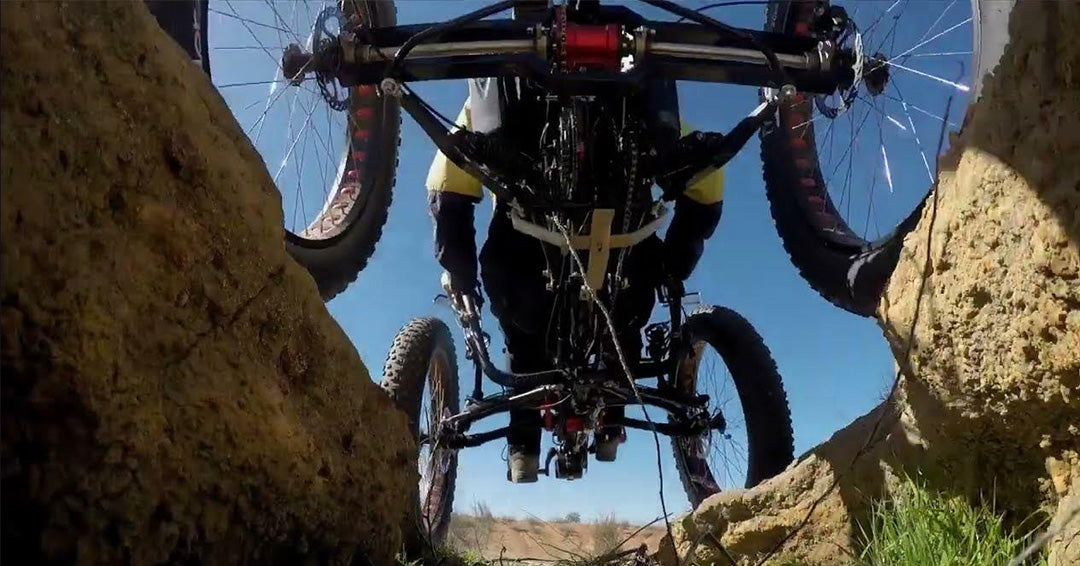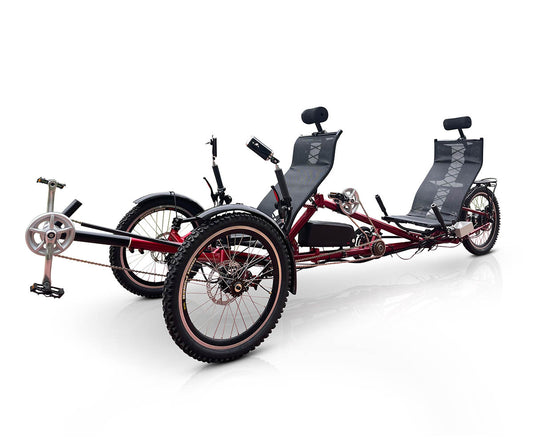
An Electric Ride: The Complete Guide to Recumbent Electric Cycles
Share
Electric recumbent cycles are emerging as a revolutionary force in the world of cycling and mobility, blending the comfort and efficiency of recumbent designs with the cutting-edge technology of electric assistance. This combination is not just transforming how we think about personal transport; it's reshaping our approach to fitness, outdoor adventure, and the pursuit of an eco-friendly lifestyle. With their ergonomic design, these cycles extend the joy of riding to a broader audience, including those seeking a more inclusive and accessible form of cycling or even a new social activity.
The Evolution of Electric Bicycles
The history of electric bicycles begins in the late 19th century with the first patents for electrically powered bikes. Pioneers like Ogden Bolton Jr. and Hosea W. Libbey introduced early concepts where bicycles were equipped with simple electric motors and batteries. These initial designs were rudimentary but highlighted the potential for powered bicycles to reduce physical strain and extend travel range.
Through the 20th century, as battery technology advanced— most recently spurred by the developing electric vehicle sector—e-bikes evolved from curiosities to compelling alternatives for urban transportation. By the 1990s, these bikes began to feature improved range, increased power, and decreased weight, making them more practical and appealing to a broader audience. This period marked a significant shift as e-bikes moved from being experimental gadgets to viable transportation alternatives.
The most recent wave of popularity around electric bikes has been aided significantly by two things, the first of which being improvements in the capacity and charging speed of lithium-ion batteries, the second being the popularity of last-mile transportation businesses dropping thousands of electric scooters and bikes in cities around the world. Now, electric bicycles are integral to urban transportation, both reducing congestion and pollution, especially in areas that are experiencing the frictions of having deprioritized public transportation over the last century. Electrified bikes, boards, and scooters can frequently outpace cars and trucks in often gridlocked downtown areas. As e-bike technology continues to evolve, these bicycles are becoming increasingly sophisticated, featuring smart integration and connectivity that enhance user experience and functionality. This ongoing innovation is attempting to ensure that e-bikes remain at the forefront of the shift towards more sustainable urban mobility. Want to dig deeper into the recent rise of e-bikes? Check out this article from The Guardian.
Today, with ongoing innovations in electric bike technology reshaping urban mobility, it can be handy to have at least a cursory understanding of the regulatory environment that governs their use. Particularly in the United States, the adoption of a three-class system by 38 states has introduced a structured approach to e-bike usage. Note: This information is up to date as of April 2024.[1][2]
The Three-Class Electric Bike System
- Class 1: These electric bikes are equipped with a motor that provides assistance only when the rider is pedaling and ceases to assist when the bicycle reaches 20 mph. Class 1 bikes are typically allowed on any bike paths or anywhere regular bikes are permitted, making them a versatile option for commuters and recreational riders alike.
- Class 2: Class 2 e-bikes also have a speed limit of 20 mph, but unlike Class 1, they feature a throttle-assisted motor, which can be activated without pedaling. These bikes are suitable for those who may need a break from pedaling due to fatigue or for convenience in stop-and-go urban traffic. However, the throttle feature may restrict them from certain trails and bike paths that prioritize pedal-only traffic.
- Class 3: These are pedal assist only e-bikes, similar to Class 1, but with a higher speed cap of 28 mph. They are often equipped with a speedometer and are primarily designed for road use due to their higher speeds. Class 3 e-bikes are not allowed on most trails and bike paths where their higher speed could pose safety risks, especially in crowded or mixed-use areas.
Regulations in Other States and Countries
In states not adhering to the three-class system, e-bike regulations vary significantly. Some treat e-bikes similarly to traditional bicycles, requiring no registration, while others impose moped-like regulations that may include licensing, registration, and mandatory helmet use. It's crucial for e-bike users in these areas to understand local laws to ensure they are compliant and safely integrated into road and trail systems.
Internationally, e-bike regulations can also differ widely. For example, in the European Union, e-bikes that do not exceed 25 km/h (15.5 mph) and have a motor of up to 250 watts are classified as conventional bicycles without requiring licensing or registration. However, faster or more powerful e-bikes fall under more stringent categories that might require licensing, insurance, and helmet use, similar to motor vehicles. Countries like China have also implemented specific regulations that address the growing popularity and unique traffic challenges posed by e-bikes, focusing on safety and traffic flow.
This diverse regulatory framework across different regions emphasizes the importance of local knowledge when using e-bikes, whether for commuting, leisure, or sport. By staying informed about these laws, cyclists can enjoy the benefits of e-bikes while adhering to legal standards and contributing to road safety and efficiency.
Exploring Electric Recumbent Cycle Varieties
Electric recumbent cycles have transformed the landscape of adaptive mobility, offering a range of models that cater to diverse needs and preferences. These vehicles come in several forms, primarily focusing on trikes and quads, each equipped with distinct power options to suit different riding experiences.
Electric Assist and Complete Electric Power
Most electric recumbent cycles are equipped with either electric assist systems, complete electric power, or a combination of both, providing flexibility in how they are used:
- Electric Assist systems activate a motor based on the rider’s pedaling effort, offering a boost that varies with the exertion level. This setup is ideal for those who enjoy cycling but appreciate a little help on tougher terrains or during longer rides.
- Complete Electric Power operates independently of the rider’s pedaling, offering a consistent motor-driven experience that is perfect for those who need or prefer not to pedal at all due to physical constraints or preferences.
Currently, the batteries used in recumbent trikes and quads typically range from 36V to 48V, with capacities extending from 11.6Ah to 20Ah, translating to energy storage between 417Wh and 960Wh. It is often possible to add extra batteries to extend the range significantly, thereby enhancing the cycle's ability to cover longer distances on a single charge. This flexibility makes electric recumbent cycles a superb choice for both leisurely rides and more demanding journeys.
For a deeper dive into the vast array of features available beyond electric capabilities, such as customization options that cater to specific needs or enhance comfort, readers are encouraged to explore our comprehensive guide on adaptive cycle features.
Advantages of Electric Tadpole Trikes
Electric tadpole trikes, characterized by their two front wheels and one rear wheel configuration, offer unique advantages that make them particularly appealing:
- Stability and Handling: The low center of gravity and wide front axle provide enhanced stability and balance, making them an excellent choice for high-speed cornering and uneven surfaces.
- Efficient Performance: Tadpole trikes often feature aerodynamic designs that reduce drag and improve efficiency, making them ideal for longer rides where endurance and comfort are paramount.
The Mechanics of Electric Assist
Understanding the mechanics of electric assist is crucial for anyone considering an electric recumbent cycle. This technology fundamentally changes how cycles operate, providing a more accessible and less strenuous riding experience.
Technical Breakdown
- Motor Placement: Electric motors can be installed in the hub of one of the wheels or at the crankset (mid-drive). Mid-drive motors are particularly effective because they offer efficient power transfer and better weight distribution, which is ideal for hilly terrains.
- Battery Integration: The cycle's range is dictated by its battery capacity, which also influences the overall weight and balance. Advanced placement strategies ensure that batteries do not interfere with the cycle’s handling.
- Sensor Systems: These include speed, torque, and cadence sensors that adjust the motor’s output for a seamless blend of human and motor power, enhancing the ride’s smoothness and responsiveness.
Pedal Assist vs. Throttle Control
- Pedal Assist (Pedelec): Activates the motor based on pedaling force, with various assistance levels selectable according to rider preference or terrain. This mode is celebrated for preserving the natural feel of cycling while reducing fatigue, which is particularly beneficial on challenging routes.
- Throttle Control: Offers motor power on demand, similar to a motorcycle, allowing riders to cruise without pedaling. This feature is excellent for those who need a break from pedaling, prefer a more relaxed ride, or have any level of lower body functional mobility limitations; throttle control is sometimes subject to stricter regulations in many areas due to its powerful capabilities.
Both pedal assist and throttle control serve to make cycling more accessible and enjoyable, particularly for people with limited physical stamina or mobility issues. By choosing the appropriate electric assist mode, riders can greatly enhance their cycling experience, enjoying greater distances and less physically demanding rides.
Benefits Beyond the Ride
Electric recumbent cycles offer a wealth of benefits that extend far beyond mere transportation. These vehicles are designed not only to enhance mobility but also to provide significant health and environmental advantages alongside promoting inclusivity.
Health Benefits
Electric recumbent cycling combines the physical benefits of exercise with the accessibility of electric power assistance, making it an excellent choice for both fitness enthusiasts and those seeking a gentle reintroduction to physical activity. Here are some key health advantages:
- Cardiovascular Health: Regular use of an electric recumbent bike provides cardiovascular exercise, which is crucial for heart health, improves stamina, and helps in weight management.
- Low-Impact Exercise: The recumbent seating position significantly reduces stress on the hips, knees, and ankles, making it ideal for those recovering from injuries or with chronic joint issues.
- Cognitive Well-being: Spending time outdoors and engaging in physical activity are both known to reduce stress and anxiety, enhance mood, and improve overall cognitive health.
As a fun side note, staying aerobically fit can drastically change what life looks like in your later decades. Want to have the aerobic capacity of a 30-year-old at 80? Here is a scientific look at the world record holder for VO2 max in an octogenarian.
Environmental Benefits
Opting for an electric recumbent cycle also contributes to environmental conservation:
- Reduced Carbon Footprint: Unlike cars and traditional motorbikes, electric recumbent cycles emit no pollutants, helping to reduce your carbon footprint.
- Energy Efficiency: Electric bikes use significantly less energy compared to motor vehicles, making them a more sustainable option for short to medium-distance travel.
Accessibility and Inclusivity
One of the standout features of electric recumbent cycles is their ability to level the playing field for many who might otherwise feel excluded from cycling:
- Stable and Comfortable Design: The low center of gravity and supportive seating increase stability and comfort, which can be especially beneficial for older adults or those with balance or mobility challenges.
- Adaptability: Features like adjustable pedal positions and supportive seating can accommodate riders of various sizes and physical capabilities, promoting inclusivity.
- Ease of Use: Electric-assist reduces the need for physical strength, opening up cycling as a viable option for individuals who might find traditional bikes too challenging.
How to Select the Right Electric Recumbent Cycle
Choosing the right electric recumbent cycle involves considering your lifestyle, needs, and budget. Here’s a guide to help you make an informed decision:
Identifying Your Needs
- Usage: Consider how you plan to use your electric recumbent cycle. Do you need it for commuting, leisurely rides, or fitness training? Perhaps you require a bike that can handle off-road conditions?
- Comfort and Fit: Make sure the bike fits your body comfortably. Adjustable features and ergonomic design are crucial for long-term satisfaction and injury prevention.
- Budget: Electric recumbent cycles can vary significantly in price. Determine how much you are willing to spend and what features are non-negotiable within that budget.
Spotlight on Innovative Models
- Latest Innovations: Stay updated with the newest models that feature cutting-edge technology in battery life, motor efficiency, and user-friendly interfaces. These models often offer enhanced performance and increased range.
- Best for Commuting: Look for models with features like integrated lighting systems, cargo storage, and additional battery capacity, which are ideal for urban commuters.
- Adventure Ready: For the more adventurous, models designed with robust suspension systems and all-terrain tires ensure a smooth ride on varied landscapes.
In addition to these criteria, it can be very helpful to test-ride several models to get a feel for different types of electric recumbent cycles. This firsthand experience can be invaluable in finding the bike that best suits your riding style and comfort preferences.
Accessories and Personalization
Customizing an electric recumbent cycle goes beyond simple aesthetics; it's about tailoring your ride to fit your exact needs and enhance your cycling experience. The modular nature of these bikes allows for a wide range of practical accessories and high-tech enhancements, making each bike as unique as its rider.
Key areas for customization include:
- Seating Options: Upgrade to ergonomically designed seats that provide better support and comfort for long rides.
- Lighting Systems: Incorporate advanced LED lighting for better visibility during night rides, ensuring safety no matter the time of day.
- Storage Solutions: Add custom panniers or cargo racks designed to handle everything from daily groceries to gear for cross-country adventures.
- Advanced Display Units: Equip your cycle with high-tech dashboards that offer navigation, ride statistics, and connectivity features.
For a complete guide to the customizable features available for adaptive cycles, explore our detailed articles on recumbent bike features and adaptive cycling add-ons & accessories. These resources will help you understand the vast potential for personalizing your electric recumbent cycle.
Looking Ahead: The Future of Electric Recumbent Cycles
The trajectory of electric recumbent cycles points toward an exciting future filled with innovation and refinement. As battery technology continues to advance, we can anticipate longer ranges and faster charging times, making electric recumbents even more appealing for both daily commuting and long-distance touring.
Future advancements may include:
- Integration of AI: Artificial intelligence could be used to provide improved adaptive power assistance, adjusting the motor output precisely to the rider's pedaling style and terrain changes, or even creating highly personalized workouts optimized to get results in aerobic or mechanical fitness as efficiently as possible.
- Solar Charging Panels: Development of lightweight, efficient solar panels that can be integrated into the bike frame to extend battery life on the go.
- Smarter Safety Features: Expect to see more sophisticated safety systems that incorporate sensors and machine learning to predict and prevent accidents.
As William Gibson famously said, "The future is already here; it’s just not evenly distributed." New waves of technological advancements in every field have recently demonstrated an extraordinary aptitude for sneaking up on us. New innovations applied to electric recumbent cycles will likely bring some futuristic concepts into our everyday lives, offering cyclists levels of convenience, efficiency, and sustainability that once might have been considered to be only science fiction.
Join the Ride: Embracing the Electric Recumbent Revolution
One could say that electric-powered adaptive and recumbent bikes may play a big role in the future of cycling, offering a blend of comfort, efficiency, and accessibility. Advanced battery technology, electric-assist mechanisms, and customizable features cater to a diverse range of needs and preferences, making cycling more inclusive.
These cycles not only enhance mobility but also open new possibilities for fitness and exploration. We invite you to discover this evolving world. Whether you're upgrading your ride or starting a new cycling journey, electric recumbent bikes provide a unique, modern experience.
Interest piqued? Join the community of electric recumbent enthusiasts. Explore our collection, connect with fellow riders, and start your journey into the future of cycling.


